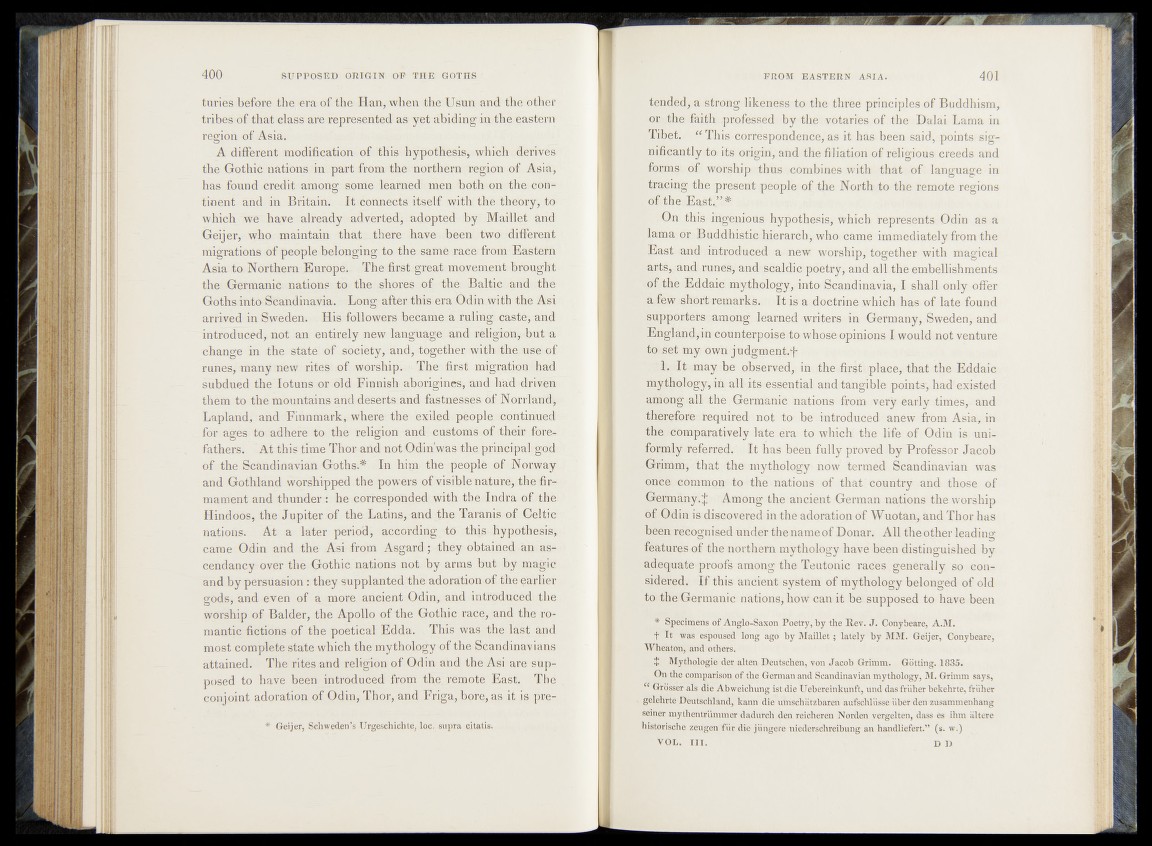
tunes before the era of the Han,
tribes of that class aie represented as yet abiding in the eastern
region of Asia.
A different modification of this hypothesis, which ..derives:'
the Gothic nations in part from the northern region of Asia,
has found credit amonst some lèarneff men O both on the. continent
and in Britain. It connects itself with the theory, to
which we have-already adverted, adopted- by ^Maillet and
Geijer, who maintain that^there have»,been two ^different
migrations of people belonging to the samejae'e from Eastern
Asia t a Northern Europe. The firsLgreafc movement? brought
the G^manie nations to the shores .of the BaItic^èè0isthè
Goths into Scandinavia. Long- after this era Qdin.wi feh the Asjy
arrived in Sweden. His followers became û rulitigfceasiej and
introduced, not an entirely new language and religion,- but a
change in the state of-society, and,.-together with 'the-usóti) f
runes, many new rites of worship, v- Therfrrst migration Chad
subdued the lotuns or old Finnish aborigines, and liad olriven
them to the mountains and deserts and fastnesses, of Norrlmtd|
Lapland, and Finnmark, where the exiled people ..eontinued1
for ages to adhere to the religion andi customs of their forefathers.
At this time Thor and not Odin’was the principal, gód
of the Scandinavian Goths.* In him the peoplé ofrNorway
and Gothland worshipped the powers of visible nature, the firmament
and thunder : he corresponded with the Indra of the-
Hindoos, the Jupiter of the Latins, and the Taranis* of Celtic*
nations. At a later period, according to this-hypothesis,
came Odin and the Asi from Asgard ; they obtained, -an ascendancy
over the Gothic nations not by arms but by magic
and by persuasion : they supplanted the adoration-of the earlier
gods, and even of a more ancient Odin, and introduced the
worship of Balder, the Apollo of the Gothic race, and the romantic
fictions of the poetical Edda. This was the last and
most complete state which the mythology of the Scandinavians
attained. The rites and religion of Odin and the Asi are supposed
to have been introduced from tb,e remote East, The
conjoint adoration of Odin, Thor, and Friga, bore, as it is pre*
Geijer, Schweden’s Urgeschichte, loc, supra oitatis.
tended, a strong1 likeness to. the three principles of Buddhism,
or the faith professed by the votaries of the Dalai Lama in
Tibet. “ This correspondence, as it has been said, points significantly
to its origin, and the filiation of religious creeds and
forms of worship thus combines with that of language in
tracing the present people of the North to the remote regions
ofitbe East.” *
this iMgepious hypothesis,’ which represents Odin as a
lama or Buddhistic hierarch, who came immediately from the
pEast.sand introduced <a mew Worship,*together with magical
|uris,, and rain@%.an,dtgcaldic poetry, and all the embellishments
.of/the.Eddaic mythology, into Scandinavia, I shall only offer
a few short»remarks,. . It is a doctrine which has of late found
.supporters .among learned writers in Germany,. Sweden, and
England,'in counterpoisëdo whpse opinions I would not venture
tor<set my own j Udgment.f
1. It%may,:be observed,3 in the .first place, that the Eddaic
,hpthal@gy%ih a ll itesêssential and tangible points; hadrexisted
among a lle le Germanic -nations from, very early times, and
thtereforfeï required not to be introduced anew from Asia, in
thectcömparatively laterèra to which the life of Odin is uniformly
referred. It has been fully proved by Professor Jacob
Grimm,3-that the mythology now termed Scandinavian was
once common to the nations- of that country and those of
Germany.^- Among the ancient German nations the worship
of Odin is discovered in the adoration of Wuotan, and Thor has
been recognised under the name of Donar. All the other leading
features of the northern mythology have been distinguished by
ad equate proofs among the Teutonic races. generally so considered.
If this ancient system of mythology belonged of old
to the Germanic nations, how can it be supposed to have been
* Specimens of Anglo-Saxon Poetry, by the Rev. J . Conybeare, A.M.
f I t was embused long ago by MaiïLét; lately by MM. Geijer, Conybeare,
Wheaton, and others.
| X Mythologie der alten Deutschen, von Jacob Grimm. Gotting. 1835.
On the comparison, of the German and Scandinavian mythology, M. Grimm says,
cc Grösser als die Abweichung ist die U eb er einkunft, und das früher bekehrte, früher
gelehrte Deutschland, kann die unschätzbaren aufschlüsse über den Zusammenhang
seiner mythentriimmer dadurch den reicheren Norden vergelten, dass es ihm ältere
historische zeugen für die jüngere niederschreibung an handliefert.” (s. w.) >
VOL. III. , D B